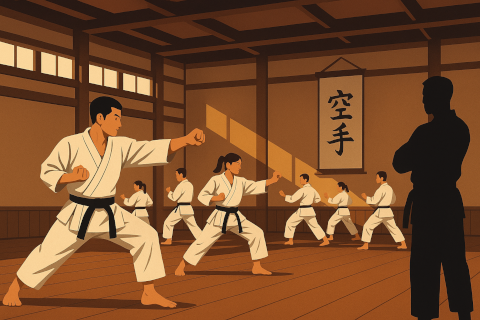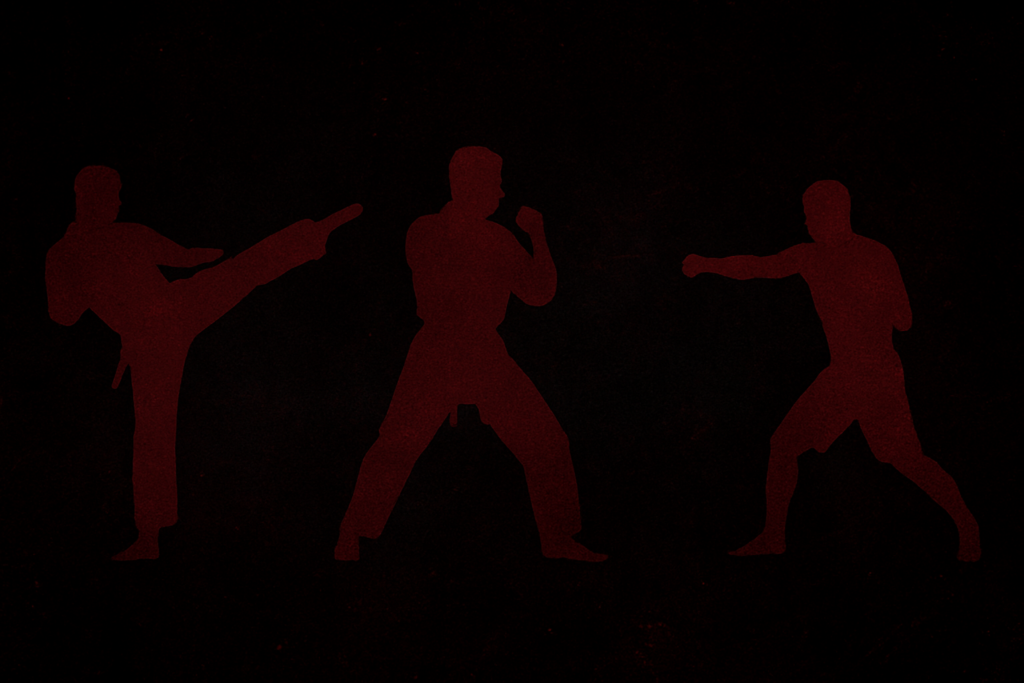Origins, Styles, and Why You Should Practice It
🥇 A Brief History of Karate

Karate (空手) — meaning “empty hand” in Japanese — is one of the most widely practiced martial arts in the world.
It originated on Okinawa, a small island between Japan and China, where native fighting systems (Te) were influenced by Chinese martial arts during the 14th–19th centuries.
In the early 20th century, Okinawan masters brought karate to mainland Japan, where it evolved into several major styles emphasizing striking, blocking, kata (forms), and disciplined spirit.
Today, karate is both a competitive sport and a lifelong discipline that develops strength, confidence, and focus.
⚔️ Main Characteristics of Karate
- Focus: Strikes using fists, elbows, knees, and feet
- Training elements: Basics (kihon), forms (kata), and sparring (kumite)
- Philosophy: Discipline, respect, and constant self-improvement (kaizen)
- Goal: Develop the mind and body as one — “the ultimate aim of karate lies not in victory or defeat, but in the perfection of character.” — Gichin Funakoshi
🏯 Popular Styles of Karate
Below are the most recognized karate styles, their founders, and what makes each unique.
🥋 Shotokan Karate
- Founder: Gichin Funakoshi (1868–1957)
- Origin: Japan (early 20th century)
- Key Traits:
- Deep, powerful stances and long-range techniques
- Emphasis on form, speed, and strong linear strikes
- Philosophical and disciplined — “karate-do” as a way of life
- Ideal For: Beginners and those seeking traditional, structured training.
🥋 Goju-Ryu Karate
- Founder: Chojun Miyagi (1888–1953)
- Origin: Okinawa
- Key Traits:
- Blend of hard (go) and soft (ju) techniques — strong strikes balanced with circular defense
- Incorporates breathing, tension control, and close-range combat
- Strong influence from Chinese martial arts
- Ideal For: Students interested in fluid, balanced, and traditional practice.
🥋 Wado-Ryu Karate
- Founder: Hironori Otsuka (1892–1982)
- Origin: Japan
- Key Traits:
- Combines karate strikes with jujutsu’s joint locks and body shifting
- Focus on evasion and redirection rather than brute force
- Smooth, flowing movements emphasizing harmony (wa)
- Ideal For: Those seeking a gentler, self-defense-oriented style.
🥋 Kyokushin Karate
- Founder: Masutatsu Oyama (1923–1994)
- Origin: Japan
- Key Traits:
- Full-contact sparring with emphasis on power and endurance
- Body conditioning, strength training, and real combat spirit
- Famous for tough kumite (fighting) and “knockdown” competitions
- Ideal For: Athletes and disciplined practitioners who enjoy challenge and realism.
🥋 Shito-Ryu Karate
- Founder: Kenwa Mabuni (1889–1952)
- Origin: Okinawa → Japan
- Key Traits:
- Extensive kata system combining hard and soft techniques
- Fast-paced transitions between strikes and defenses
- Great for developing precision and versatility
- Ideal For: Students who enjoy technical detail and kata study.
🥋 Kempo (Kenpo) Karate
- Founder: James Mitose (1916–1981)* (modernized in the U.S. by Ed Parker, 1931–1990)*
- Origin: Japan / Hawaii / USA
- Key Traits:
- Hybrid martial art combining traditional karate with Chinese and Western self-defense
- Emphasizes practicality, adaptability, and rapid striking combinations
- Focused on real-world application
- Ideal For: Practitioners looking for a modern, effective self-defense approach.
🧘 Why Practice Karate?
Karate is far more than physical training — it’s a path to balance body, mind, and spirit.
Physical Benefits:
- Improves strength, flexibility, and coordination
- Builds cardiovascular endurance and balance
Mental Benefits:
- Develops focus, patience, and confidence
- Encourages humility and respect through etiquette and tradition
Lifestyle Benefits:
- Suitable for all ages — children, adults, and seniors alike
- Adaptable intensity, from light traditional practice to full-contact competition
🥋 Karate teaches you to face challenges head-on — both on the mat and in life.

